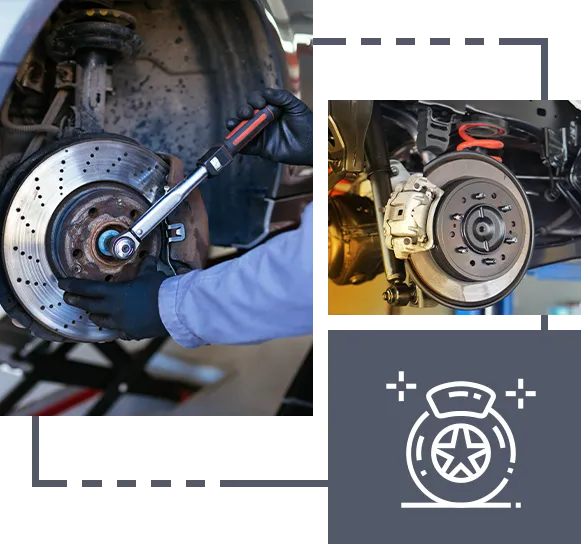Brake Repair

How to tell a complete brake job from one that’s not
Ever wonder how repair shops know what cost to advertise for a brake job if they don’t know what the problem is? They don’t. We believe you can only tell what a brake job will cost after a thorough inspection of the brake system. You really do get what you pay for.
How Brakes Work
When you press down on the brake pedal, brake fluid is sent from the masters cylinder, which is the little white box under the hood of your vehicle, through brake fluid hoses down to the brake calipers.
With hydraulics, the brake fluid causes the caliper, which houses two brake pads, to squeeze against the spinning rotor in each wheel. This action creates friction and slows the vehicle. Some vehicles have drum brakes in the hack. When the brake pedal is pushed, a piston pushes the brakes shoes against the drum.
Through use, the friction material on the brake pads and the surface of the rotor wear down and get dirty and rusty. Parts need to be cleaned, replaced and readjusted.
There is a difference in brake repair.
There are complete Jobs & Jobs that aren’t.
1. TEST DRIVEN
2. COMPLETE M.A.P. INSPECTION IS DONE
The brakes of all four wheels are checked, including the parking brakes using the Motorist Assurance Program guidelines. The results are documented and explained to the customer. A lot of garages don’t follow M.A.P. guidelines.
3. A QUOTE IS GIVEN
A quote is given on what is needed, and only an approved repair is done, which includes servicing the rear brakes. They are cleaned, re-lubricated and adjusted. Most only check the front brakes because they wear faster than the rear.
4. FLUID IS CHANGED
Old, dirty brake fluid in the master cylinder is drained and replaced. Other garages don’t replace the contaminated brake fluid.
5. ROTORS ARE MEASURED AND CHECKED
Thickness variation of all the rotors is measured with a micrometer. Variations can cause brake pedal pulsation or the steering wheel to shake as the vehicle stops. The rotor vanes, or cooling fins, are checked for mud and rust. Clogged vanes could affect the rotors’ ability to remove heat from the brakes. This could lead to premature wear. Not every garage does this.
6. FLUID IS REPLACED FROM THE LOWER PART OF THE SYSTEM
The dirty brake fluid is drained. A special clamp is attached to the hose leading into the caliper before pushing in the caliper piston to remove the caliper. This prevents the remaining contaminated fluid in the caliper from flowing hack into your vehicle’s anti-lock braking system, which can easily damage that costly unit. Many force the piston in and push dirty fluid hack into the ABS unit.
7. WHEEL HUB IS CLEANED
Dirt and rust build-up is cleaned from the hub and the hardware is replaced. Not cleaning the hub can cause lateral run out. (See step 8.) Others don’t take the time.
8. EACH HUB AND ROTOR ARE CHECKED FOR LATERAL RUN OUT
A new or resurfaced rotor is checked for lateral run out when its attached to the hub. That’s when the rotor, while spinning, is not perpendicular to the wheel and it wobbles. It causes extra rotor wear and pedal pulsation
9. PARTS ARE LUBRICATED
All metal-to-metal parts are lubricated. Others don’t take the time.
10. PROPER TORQUE IS USED
The wheels are put back on, each torqued to the proper specifications. Many don’t torque at all.
11. CALIPERS ARE READJUSTED
Break pedal is gently pumped to get the calipers readjusted. Pumping too fast can damage the master cylinder.
